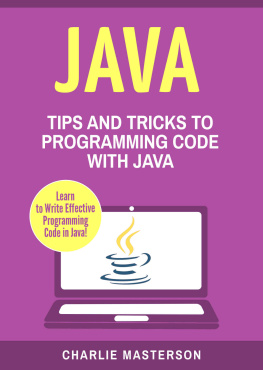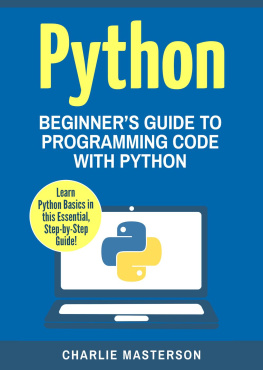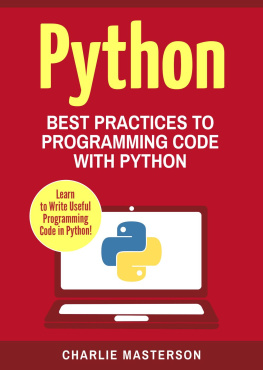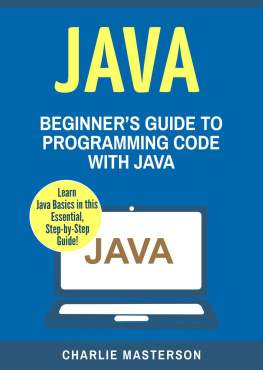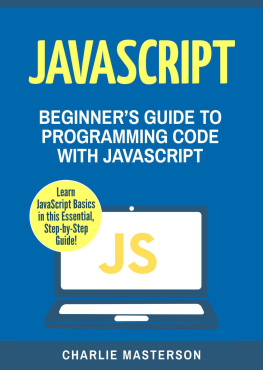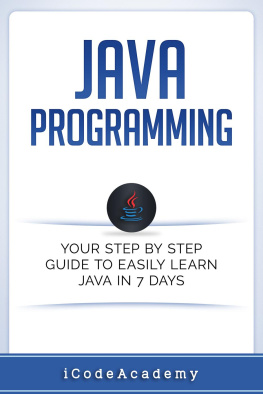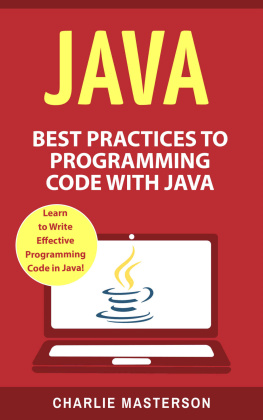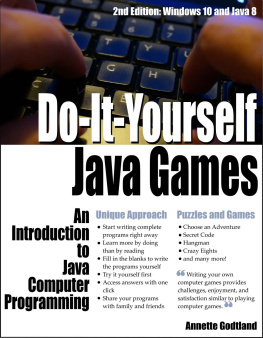Charlie Masterson - Java: Tips and Tricks to Programming Code with Java
Here you can read online Charlie Masterson - Java: Tips and Tricks to Programming Code with Java full text of the book (entire story) in english for free. Download pdf and epub, get meaning, cover and reviews about this ebook. year: 2017, genre: Computer. Description of the work, (preface) as well as reviews are available. Best literature library LitArk.com created for fans of good reading and offers a wide selection of genres:
Romance novel
Science fiction
Adventure
Detective
Science
History
Home and family
Prose
Art
Politics
Computer
Non-fiction
Religion
Business
Children
Humor
Choose a favorite category and find really read worthwhile books. Enjoy immersion in the world of imagination, feel the emotions of the characters or learn something new for yourself, make an fascinating discovery.
- Book:Java: Tips and Tricks to Programming Code with Java
- Author:
- Genre:
- Year:2017
- Rating:3 / 5
- Favourites:Add to favourites
- Your mark:
- 60
- 1
- 2
- 3
- 4
- 5
Java: Tips and Tricks to Programming Code with Java: summary, description and annotation
We offer to read an annotation, description, summary or preface (depends on what the author of the book "Java: Tips and Tricks to Programming Code with Java" wrote himself). If you haven't found the necessary information about the book — write in the comments, we will try to find it.
Charlie Masterson: author's other books
Who wrote Java: Tips and Tricks to Programming Code with Java? Find out the surname, the name of the author of the book and a list of all author's works by series.
Java: Tips and Tricks to Programming Code with Java — read online for free the complete book (whole text) full work
Below is the text of the book, divided by pages. System saving the place of the last page read, allows you to conveniently read the book "Java: Tips and Tricks to Programming Code with Java" online for free, without having to search again every time where you left off. Put a bookmark, and you can go to the page where you finished reading at any time.
Font size:
Interval:
Bookmark:
Java:
Tips and Tricks to Programming Code with Java
Charlie Masterson
Table of Contents
Copyright 2017 by Charlie Masterson - All rights reserved.
The contents of this book may not be reproduced, duplicated or transmitted without direct written permission from the author.
Under no circumstances will any legal responsibility or blame be held against the publisher for any reparation, damages, or monetary loss due to the information herein, either directly or indirectly.
Legal Notice:
This book is copyright protected. This is only for personal use. You cannot amend, distribute, sell, use, quote or paraphrase any part or the content within this book without the consent of the author.
Disclaimer Notice:
Please note the information contained within this document is for educational and entertainment purposes only. Every attempt has been made to provide accurate, up to date and reliable complete information. No warranties of any kind are expressed or implied. Readers acknowledge that the author is not engaging in the rendering of legal, financial, medical or professional advice. The content of this book has been derived from various sources. Please consult a licensed professional before attempting any techniques outlined in this book.
By reading this document, the reader agrees that under no circumstances are is the author responsible for any losses, direct or indirect, which are incurred as a result of the use of information contained within this document, including, but not limited to, errors, omissions, or inaccuracies.
I ntroduction
Congratulations on downloading Java: Tips and Tricks to Programming Code with Java and thank you for doing so.
The following chapters will discuss how you can use Java and what tips and tricks you are going to be able to use to further what knowledge you know on Java.
This book is mean to help you push past the most basic of knowledge and find easier ways for you to be able to use Java so that it can benefit you.
There are plenty of books on this subject on the market, thanks again for choosing this one! Every effort was made to ensure it is full of as much useful information as possible, so please enjoy!
Chapter 1:
Hibernation in Implementations that are Standalone
Before you can begin to develop a project, you need to be able to have a strategy that is going to work well with the data that you are inputting into the program.
This is something that needs to happen no matter what project that you are working on so that you know where you are supposed to go instead of trying to do whatever and potentially mess up what you are trying to do. Not only that, but you are going to be able to use a framework that is going to be reliable and improve your project over the course of the time that it is used.
However, if you are using a framework that is unstructured and cannot be controlled you are going to end up having to continuously fix your project and spend money on trying to maintain it properly so that it does not change your code and mess up your entire project.
Basically, making sure that the framework that you decide to use is going to make sure that your project is protected and has the proper tools that are needed to debug your project.
The hibernate validator is going to a project that is open sourced and will help when it comes to demonstrating key features or composing rules that are going to be valid.
Hibernate Validator
The validator for the hibernate is going to be a foundation that is built solidly but will allow for you to write code that is flexible and lightweight for Java EE and SE. The validator is going to be able to help with different frameworks that are going to be used when working with Java but you are also going to be able to use frameworks that are going to standalone.
The Java SE standalones are going to become very important parts of the application on the server side for more complex heterogeneous.
To be able to use the validator so that you can build a component that is stand alone, you are going to want to make sure that you have JDK version six or higher installed on your computer.
Having this version is going to make it to where you can use the 5.0.3 version of the validator by downloading version five of the hibernate binary distribution package. Your directory is going to have all of the binaries that you need to make sure that you are able to build implementations that are stand alone.
The first example will show you how an ant built script is going to have the dependencies that are going to be for standalone implementations under the manifest section. This section is going to be required for the metadata that is outside of the code that you are writing. Because of the ant build, you are going to have all of the validators that are dependent JARs through the header of class-path for the manifest file.
Example: manifest section with ant build and dependencies
CODE:
< / manifest >
Annotation declaratives and definitions for constraints
With version five of the hibernate validator, you are going to have an implementation that is open for the JSR bean validation version 1.1. Annotations for the declaratives and the definition for constraints is going to have two highlights for the bean validation framework that has been updated.
When you look at the rules for validation that are made through the syntax for declaratives is going to improve how your code is read.
Example: declarative annotations
CODE:
Open class place {
@codeishere
Closed string nameofwholiveshere ;
@morecode
@pattern ( regapd [ D-Ej-d] \\ j[ D-Dj-d] ? \\ j]D-Ej-d\\\ j , readme = this is not the correct address for this person. )
Closed string codeforcity
@codehere
Closed string city;
@morecode
@pattern (regapd = FH|ME|EL| EJ| AL| EE| ME| DI| AO| EM | NE| OI| LA} , readme = this is not the correct city for this zip code )
Closed string zipcode ;
The validation method is going to have conditions that are going to be defined based on conditions that were set before so that the code is improved on readability. The rules for this are going to be easier for you to understand being that you will only need to take notice of the annotations and methods that are being used.
Declarative styles are going to be delete the necessary need to have a model for execution due to transitions of the different states all while analyzing the conditions that are going to come before and after the code.
Constraints will apply to the objects that fall under the @valid annotations.
Chapter 2:
SharePoint Services on the Internet that Use a Java Client
For this chapter you are going to learn CRUD operations for SharePoint documents that use a Java client. It is going to focus on the web services that are going to be found in the copy and list services that you can use with Microsoft.
CRUD services can also be used with CAML which stands for Collaborative Application Markup Language. It is based on XML that is going to utilize the different methods that are going to be used with copy and lists.
On top of that you are going to be able to construct a CAML structure that is going to be able to pass through the different conditions that are going to be set for the properties that are assigned to the objects in the code.
Background
In the event that you are working with a large amount of data that may be in different forms, you are going to be able to look at that data in a compounded file so that you can make any decisions that you need to make. There are different kinds of monitoring that is going to happen in this kind of environment.
An audit is going to make sure that the data you are working with is going to be in a constant state and then these reports can be sent out to the people that need to have them in order for them to be saved to SharePoint.
Next pageFont size:
Interval:
Bookmark:
Similar books «Java: Tips and Tricks to Programming Code with Java»
Look at similar books to Java: Tips and Tricks to Programming Code with Java. We have selected literature similar in name and meaning in the hope of providing readers with more options to find new, interesting, not yet read works.
Discussion, reviews of the book Java: Tips and Tricks to Programming Code with Java and just readers' own opinions. Leave your comments, write what you think about the work, its meaning or the main characters. Specify what exactly you liked and what you didn't like, and why you think so.

